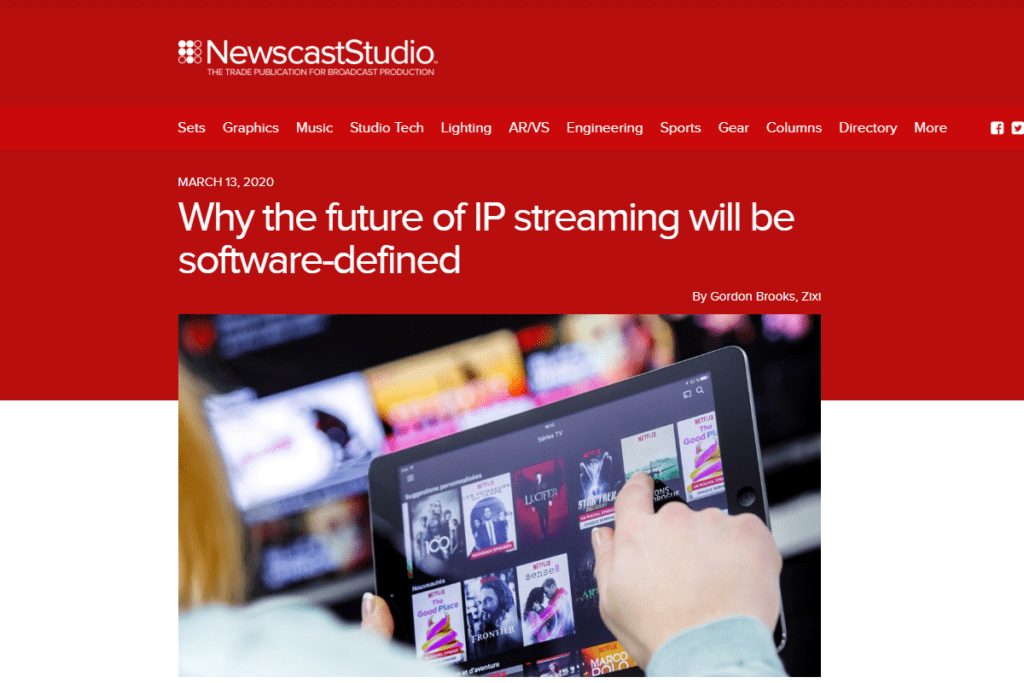In a series on the “Future of IP Streaming” for NewscastStudio, Zixi CEO Gordon Brooks discussed the IP revolution that’s currently underway and makes a case for why the future of IP Streaming will be dependent on software-based solutions like Zixi’s Software-Defined Video Platform.

Why The Future of IP Streaming Will Be Software-Defined
By Gordon Brooks, Executive Chairman and CEO, Zixi
We are currently at the forefront of an IP revolution. For nearly 80 years, the broadcast industry relied on expensive, inflexible infrastructure comprised of bulky and disparate hardware systems and long-term vendor agreements that were ripe to be disrupted. But now, an industry that was slow to change has awoken to the possibilities of a more flexible, dynamic future and today we are seeing the adoption of IP for live and live linear video delivery across the media industry. We are going through one of the most rapid and significant industry transformations in history and IP is a huge enabler of this movement.
The media industry is migrating quickly to hybrid IP networks to transport broadcast-quality live and live linear video through and across its workflows. IP networks can be the internet, fiber, cellular (4G,5G), or IP over satellite, and with the right video platform can consist of combinations of hybrid networks with bonded or sequential hitless networks for 99.999% + reliability.
There are a number of factors driving this change:
- The rise of consumer cord cutting, affecting how and where content is consumed
- The need to provide a faster time to market
- A rapid move to Cloud Virtualization for more cost-effective, flexible broadcast infrastructures
- Mega-merger integration of companies in the media space
- The increased desire to move from a CapEx to OpEx business model
- Relentless pressure to cut costs
- The impending localization of 5G and its impact on how much C-Band will be available for broadcast and the interference factor
Make no mistake, views are changing on how broadly to use IP networks as the backbone of media workflows, especially the open internet. Yet despite the prevalence of this “IP Adoption” trend, there remain some industry hold outs who still need to be persuaded that IP networks can be as, or even more reliable than satellite and fiber when architected correctly.
When I talk to folks still exploring the many faceted world of IP solutions, I often refer to a book I read recently from the 1800s called “Flatland: A Romance of Many Dimensions”, an allegory intended to facilitate a new view of the realm of the possible. In the book, a square meets a sphere but since the square lives in a flat, two-dimensional world, it can only see the sphere as a circle. It is not until the sphere brings the square into its multidimensional world and experiences life in 3D, that the square fully realizes the potential of the sphere, and what’s possible for itself in this new world view. Like the sphere, Zixi sees that IP is already enabling a more multi-dimensional world, full of possibility for broadcast infrastructures, cloud architectures and streamlined workflows. What is happening over IP today was unheard of only a few years ago. Only once you experience the multi-dimensional world of IP do you realize fully the potential of what IP can do for your business.
With Scale Comes Complexity and the Need for a Software-Defined Video Platform
Zixi has been around for 12 years focused solely on live and live linear video transport over IP. In that long history, we have seen almost every use case out there and helped many clients scale from simple point-to-point solutions to point-to-multipoint with thousands of channels. To manage and enable broadcast-quality content across that type of scale, a Software-Defined Video Platform (or SDVP) is required.
A good metaphor for a Software-Defined Video Platform is the smartphone. Today’s smartphone is hardware-defined communication and entertainment platform. The smartphone combines many disparate systems into one, but is open, so it is interoperable with many technologies and applications. In media, a Software-Defined Video Platform provides the feature capabilities of many disparate systems and is open to any IP network, any protocol, any cloud and any edge device. It must be complete, operate at true scale and be able to reliably distribute any live video from, and to anywhere in the world securely and at broadcast-quality.
There are 4 major components of a successful Software-Defined Video Platform. Think of a strong sturdy vehicle needed to transport your valuable content. You need wheels and tires (Protocol), you need the chassis of the vehicle (Video Solutions Stack), telemetry and steering (Control Plane) and the roads and infrastructure to get you there (The Network).
- Protocol Acceptance:
A Software-Defined Video Platform should afford its users the ultimate flexibility, and this means the ability to accept any protocol content providers and distributors choose to utilize. The protocols in use should be congestion and network-aware, with the capability to dynamically adjust to varying network conditions and employ forward error correction techniques for error-free video transport. Not all protocols are created equal, so choose carefully. - A Video Solutions Stack:
A Software-Defined Video Platform should provide essential software tools and core media processing functions that enable broadcasters to transport live video over any IP network. The solutions stack should offer extensive media-processing features across all the protocols such as failover techniques to ensure reliability, compatibility with any public or private cloud, and any IP network type, protocol switching, live transcoding & repackaging, analytics and more. - A Control Plane to Cost-Effectively Manage Complex Deployments at Scale
A Software-Defined Video Platform must provide control over large complex networks with visual tools to configure, provision, orchestrate, manage and monitor live broadcast channels at scale across hundreds and thousands of compute instances. More than a monitoring tool, the control plane should also allow for control of the edge, network and cloud with full telemetry visualization of streams. Essential tools like workflow visualization, alerting, history, automation, scheduling, reporting, and root cause analysis across complex media supply chains is a must. This one centralized control plane allows broadcasters to manage complex deployments at scale with more cost-effective operations personnel rather than costly teams of video engineers, which are scarce. - A Network of Integrated Partners to Ensure Interoperability and Future Proofing – The ANY Requirement:
A Software-Defined Video Platform must give its users the advantage of a wide range of hardware and software partners so that they can adapt to future pivots with ease. Users should be able to integrate seamlessly with hundreds of software and hardware partners to move live video across any IP network, any protocol, any cloud provider, and any edge device. With such openness and interoperability throughout the video supply chain, the extent of one’s live streaming reach can be virtually boundless.
Navigating the Great Migration to IP
Given the great migration of TV audiences, the maturity of required technologies across networks and the relentless pressures to increase monetization while reducing costs, the age of broadcast IP has arrived. As you shape your strategy to adopt IP delivery, beware the “Open Source is free” trap. There is nothing wrong with Open Source – at Zixi we support some Open Source protocols – but Open Source is never really “free” and can be very expensive as you try to build your own Software-Defined Video Platform. Remember the protocol is just the tire of the vehicle you really need. One of our large customers did a build-versus-buy analysis and concluded that the total cost of ownership (TCO) to internally build versus buying was 4x more expensive. Analysis like this is why AWS’s MediaConnect offering is built on Zixi’s Software-Defined Video Platform for the protocols they support.
The future of streaming is certainly over IP. In the global arena of media and entertainment companies, the acts of provisioning, deploying, orchestrating and monitoring large complex IP workflows require a full arsenal of capabilities that only a robust Software-Defined video solution can provide. If the major media networks and OTT providers trust IP solution for the Superbowl, Olympics, World Cup, Premier League, and much of the live linear TV that audiences enjoy today, you can as well, with confidence. As the great migration of the media landscape continues its trajectory, your success will be far greater with a Software-Defined Video Platform at your disposal.
About Gordon Brooks, Zixi

Gordon Brooks is the Executive Chairman and CEO of Zixi. With more than 30-years of software and services technology leadership, Gordon not only leads Zixi’s strategic direction, but also oversees day-to-day execution of Zixi’s strategic plan. He has served as CEO for five different companies, founding, launching or turning around eight companies in total. Two of Gordon’s IPO’s and five private sales created over $13 billion in value. Before joining Zixi, Gordon was President of C3 IoT, a big data, IoT and predictive analytics software platform company which provides the capability to design, development, deploy and operate complex large-scale AI applications. Gordon holds a Bachelor’s Degree from the University of New Hampshire. He has attended advanced graduate programs at Seton Hall University and Northwestern University.

